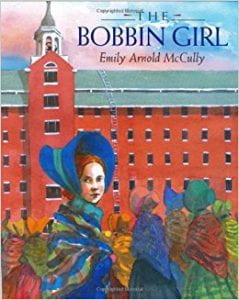 Rebecca Putney is a bobbin girl who helps support her struggling family by working all day in a cotton mill. Working conditions at the mill are poor, and there is talk of lowering the workers’ wages. Rebecca’s friend Judith wants to protest the pay cut — but troublemakers at the mill are dismissed. Does Rebecca have the courage to join the protest?
Rebecca Putney is a bobbin girl who helps support her struggling family by working all day in a cotton mill. Working conditions at the mill are poor, and there is talk of lowering the workers’ wages. Rebecca’s friend Judith wants to protest the pay cut — but troublemakers at the mill are dismissed. Does Rebecca have the courage to join the protest?
About the Author
 Emily Arnold McCully won the Caldecott Medal and has illustrated over one hundred books for young readers. Her nonfiction work for young adults, Ida M. Tarbell: The Woman Who Challenged Big Business, and Won!, was a finalist for the YALSA Award for Excellence in Nonfiction. (Scholastic.com) “I love drawing stories about brave girls, and historical subjects that shed a new light on the past. I never dreamed that I would be a children’s book author when I was young, but it turns out that I was preparing myself to be just that all along.”-Emily Arnold McCully
Emily Arnold McCully won the Caldecott Medal and has illustrated over one hundred books for young readers. Her nonfiction work for young adults, Ida M. Tarbell: The Woman Who Challenged Big Business, and Won!, was a finalist for the YALSA Award for Excellence in Nonfiction. (Scholastic.com) “I love drawing stories about brave girls, and historical subjects that shed a new light on the past. I never dreamed that I would be a children’s book author when I was young, but it turns out that I was preparing myself to be just that all along.”-Emily Arnold McCully
“Beautifully composed watercolor paintings give a vivid impression of America in the 1830s and bring the period to life. A useful book for history units.” –Booklist
“McCully deftly weaves feminist themes into her spirited text, and her meaty author’s note places her story in context. Her characters speak of self reliance and education.” -Publishers Weekly
Tips for The Bobbin Girl
- Incorporate The Bobbin Girl into a history unit on the early to mid-1800’s and the lives of factory workers.
- Read the Author’s Note found in the back of the book. Discuss the real life bobbin girl, Harriet Hanson Robinson. Assign older children biography report projects on influential people, including Robinson, during this time.
- Utilize word walls and language walls to discuss unknown words, pictures, or ideas. Allow students to describe things such as a parlor, boarding house, or bobbin, through using their own language.